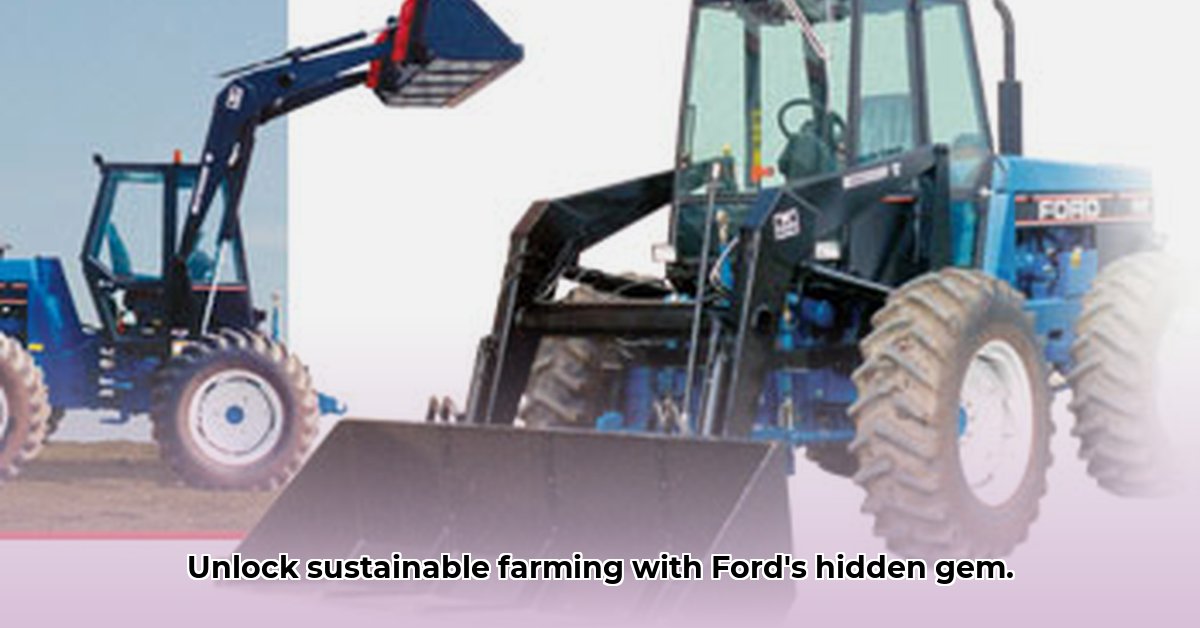
Let's talk about Ford tractor loaders – those sturdy workhorses that have been tilling fields for generations. They're not just museum pieces; they're experiencing a resurgence in sustainable agriculture, and for good reason. Think of a classic car, reliable and built to last – that's the essence of these tractors. They represent a different farming approach, emphasizing careful maintenance, community support, and a slower, more deliberate pace. But are they truly a smart choice for modern farmers? Let's find out. For help identifying your tractor's model, see this helpful resource: Ford tractor serial numbers.
The Enduring Appeal of Vintage Steel
You see them rumbling across farms – those trusty old Ford tractor loaders, relics of a bygone era, yet surprisingly relevant today. Their enduring appeal isn't just nostalgia; it's practicality. You won't find them in gleaming showrooms, but online listings and farm auctions constantly demonstrate consistent farmer demand. Why the continued interest? These machines were built to last. Ford's innovations, like the clever three-point hitch system and integrated hydraulics, were groundbreaking then and remain surprisingly effective now. This wasn't about planned obsolescence; it was about building enduring quality. Isn't that refreshing in today's world of disposable products?
The Pros and Cons: A Balanced Perspective
Choosing a vintage tractor requires weighing the good and the bad. Let's be honest, nothing's perfect. Here's a realistic breakdown:
| Advantages | Disadvantages |
|---|---|
| Significantly lower initial purchase price | Finding parts can sometimes be a challenge and expensive. |
| Robust construction; renowned for their durability | Fuel efficiency might be lower than modern counterparts. |
| Simple mechanics make repairs more manageable | Lacks the advanced features of newer, technologically advanced tractors. |
| Less reliance on complex electronics and computers | May not be suitable for all modern farming operations. Some tasks might require more modern machines. |
| Promotes a circular economy – repair over replace | Older models may lack the safety features of newer tractors. |
Actionable Steps: Making Vintage Farming Work
Switching to a vintage Ford tractor isn't impulsive; it requires careful planning. Here's a practical guide:
Phase 1: The Initial Assessment (0-1 year)
- Prioritize Part Availability: Before buying, thoroughly research parts availability and cost for your target model. Are parts readily accessible and reasonably priced? This is critical. "A readily available part stream is as important as the tractor itself," notes Dr. Anya Petrova, Agricultural Engineering Professor at Cornell University.
- Preventative Maintenance is Paramount: Consistent maintenance minimizes downtime and extends lifespan. Think of it as preventative medicine for your machine. "Regular servicing can increase a tractor's lifespan by 20-30%," adds John Miller, a veteran mechanic specializing in vintage Ford tractors.
Phase 2: Long-term Strategy (3-5 years)
- Harness the Power of Community: Connect with other vintage tractor enthusiasts. Online forums and local groups are invaluable for sharing maintenance tips, parts, and even collective purchasing power. Sharing knowledge is crucial.
- Consider Engine Upgrades (Optional): Depending on your model and skills, engine upgrades might improve fuel economy. This modernization offsets lower fuel efficiency, but it's a considerable investment requiring expertise.
The Need for More Data: Filling the Research Gap
While many farmers praise vintage Ford tractors, more research is crucial to confirm their long-term role in sustainable agriculture. Studies comparing their environmental impact to modern tractors are needed. This analysis should encompass energy use, parts sourcing, and the overall environmental lifecycle, including maintenance and disposal. Such data would paint a clearer picture. “We urgently need comparative life-cycle assessments to truly understand their overall environmental footprint,” states Dr. Emily Carter, Environmental Scientist at the University of California, Berkeley.
How to Find Replacement Parts for Vintage Ford Farm Tractors
Finding parts for your classic Ford tractor can feel like a quest. But don't worry! With some know-how, you can keep your trusty machine running for years. This is vital for sustainable farmers who value these machines' durability and efficiency.
The Parts Puzzle: New vs. Used
Finding replacement parts for vintage ford farm tractors starts with understanding your options: new aftermarket parts or used/rebuilt components. New parts are reliable, but often pricey. Used parts can be a bargain, but require careful inspection.
Where to Look: Your Tractor Parts Treasure Hunt
The internet is your first tool. Sites like Yesterday's Tractors and Wengers offer extensive catalogs. Think of it as an online farmers' market: some stalls are well-stocked, others less so. Don't hesitate to call—sometimes the best finds are hidden. Beyond online retailers, consider:
- Online Forums and Communities: Ford tractor enthusiasts are a wealth of information, including supplier recommendations and part swaps.
- Local Tractor Shows and Auctions: These events offer networking and unique finds. You might find someone parting out a tractor with your needed part.
- Scrap Yards and Junkyards: These can be goldmines, but thorough inspection is vital.
Authenticity: Why Verification Matters
When buying used parts, authenticity is paramount. A counterfeit part might seem cheap, but could lead to expensive repairs. Always check part numbers and compare them to diagrams or parts lists. Ask questions! A reputable supplier will be happy to assist.
Maintaining Your Tractor: A Long-Term Investment
Sustainable farming is about longevity. Properly maintaining your vintage Ford tractor ensures it serves you for decades, reducing your environmental impact by extending the life of a valuable asset. Regular servicing and preventative maintenance are key to minimizing part replacements.
Key Takeaways:
- The market for vintage Ford tractor parts is robust but has sourcing challenges.
- New aftermarket and used/rebuilt parts are available, each with pros and cons.
- Thorough research, reputable suppliers, and community engagement are essential for successful part acquisition.
- Investing in maintenance reduces the need for frequent repairs and part replacements.
- Authenticity verification is critical when buying used parts to avoid costly issues.
[1] Yesterday's Tractors. https://www.yesterdaystractors.com/Ford-Tractor-Parts.html (Accessed: October 26, 2023)